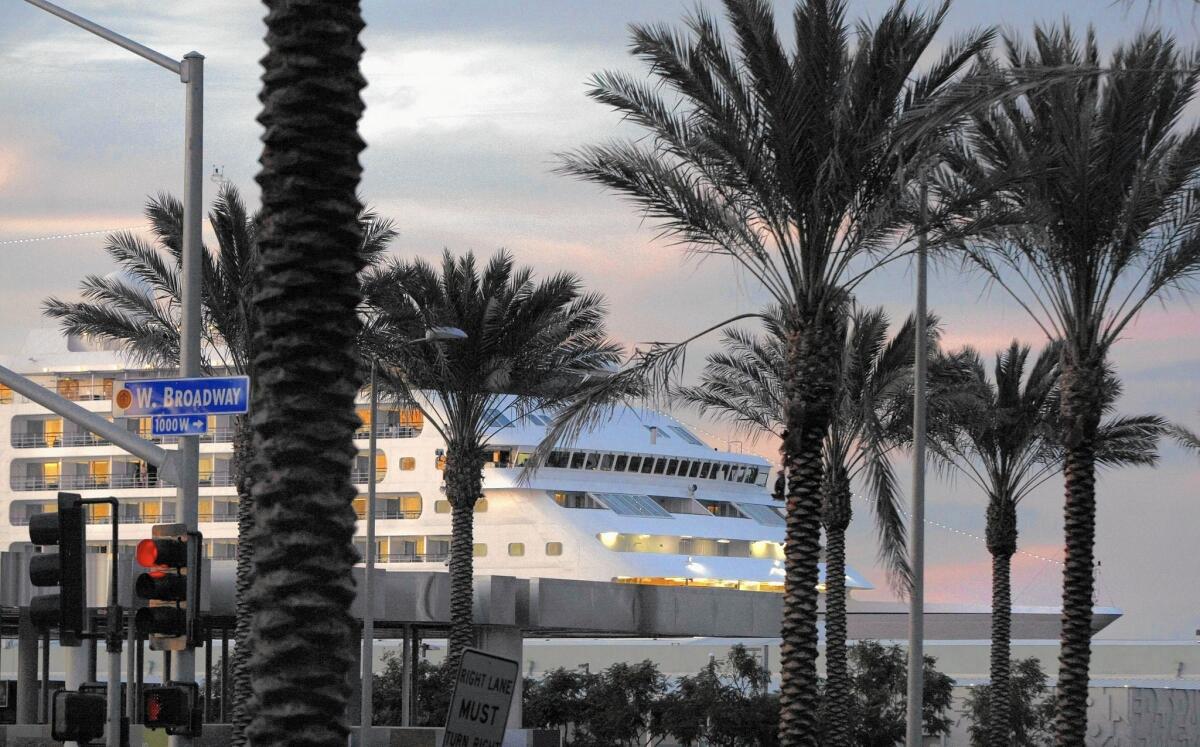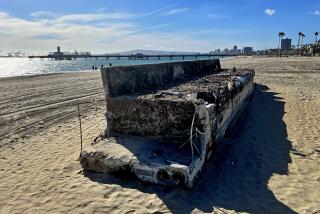San Diego’s waterfront makeover is heavy on public space

Where traffic was once dominant, tourists now sit on waterfront benches made of Alaska yellow cedar and watch luxury liners and tour boats glide into place.
Newly planted jacaranda and palm trees help set the mood.
As civic upgrades go, the recent makeover of this stretch of San Diego’s waterfront is far from grand.
But it marks an important step in the city’s quest to devote more land along the water for public use. To create this promenade, the city reduced Harbor Drive by several lanes and gave that space over for recreation. It’s part of a national movement to open up more marine spaces in cities for people to walk and play by moving roads and freeways away.
Boosters see the promenade as a possible step to two much more ambitious projects on or near the waterfront: expansion of the convention center and construction of a new football stadium.
City Council President Todd Gloria calls the flurry of activity at the waterfront and elsewhere “reclaiming public spaces for people” — a considerable feat in a city where voters are notoriously pinch-penny, having failed to sufficiently support a half-cent sales tax to boost police protection and other city services.
“We’re cheap,” said Michael Stepner, a longtime civic planner and architect. “We talk about all these things we want, but we don’t want to spend the money. In San Diego, it’s two steps forward, then two steps backward.”
San Diego has had its share of large-scale, land-use successes: downtown condominium projects, high-rise hotels, the Gaslamp District entertainment zone, a new central library and, in years further past, a gleaming waterfront convention center, Petco Park for the Padres and the Horton Plaza mall.
But the planning and construction process in San Diego is long and politically torturous, best counted not in years but in decades because of litigation, design disputes, overlapping jurisdictions and a tax-averse populace.
So any time officials overcome these obstacles, they savor the moment.
“Today, San Diego gets the embarcadero it deserves,” Mayor Kevin Faulconer said at a festive event last month to publicly unveil the $31.1-million project along Harbor Drive from Navy Pier to B Street, at the foot of Broadway.
“We persevered,” Faulconer said. “Now we have a showpiece to demonstrate that it can be done.”
The North Embarcadero Visionary Plan was discussed, planned and fought over for 20 years before construction began three years ago.
The site now provides the perfect San Diego Bay backdrop for selfies and marriage proposals, said former Port Commission member Michael McDade, a leader in bringing the project to fruition.
The benches and jacaranda trees are on property that was once busy with lanes of traffic. There is still traffic, but it has been pushed back 60 feet, providing a promenade 105 feet wide and the length of three football fields.
The upgraded embarcadero, called the city’s “new front porch” by local boosters, is one of several projects planned or underway that could brighten popular stretches of the city already bustling with tourists: notably one at Balboa Park and another at Horton Plaza Park.
In the case of the waterfront improvements San Diego is squarely in the middle of a national movement to push back on the hegemony of the automobile and make public spaces accessible to pedestrians, said Ed McMahon, senior resident fellow at the Urban Land Institute in Washington, D.C.
“Cities have realized that if you design around cars, you get more cars,” McMahon said. “But if you design around people, you get more people. And for a tourist city, that means people will stay longer and spend more money.”
Kiosks will soon offer tickets for tour boats and sight-seeing buses, and, by summer, a Mexican cafe will open. A public restroom, using concepts by noted artist Pae White, combines functionality and a tinge of whimsy inspired by the 1970s book “Jonathan Livingston Seagull.”
Two of the most popular tourist attractions are an easy walk from the new promenade — the Navy carrier museum Midway and the Maritime Museum of San Diego, with its flagship the Star of India.
For the waterfront, the current project is just phase one, although yet to be found is money for additional phases that would further reduce traffic, expand walkways and reduce view blockage.
“Let this be the exemplar for other important projects,” Gloria said.
In Balboa Park, parking places were removed to create a plaza near the Old Globe theater, the Museum of Art and the El Prado restaurant and close to the Spreckels Organ Pavilion and the Japanese Friendship Garden.
At the downtown Horton Plaza Park, in front of the shopping mall, the century-old park is being tripled in size to 37,000 square feet to include additional grass, trees, benches and food vendors. The building that once housed Planet Hollywood has been torn down to make room.
The shopping mall operator has promised to provide 200 events a year with private funding, including a farmers market and concerts, a process called “activating the space” in planner-ese.
To move the waterfront project forward, a joint-powers agreement was formed among the city of San Diego, the Unified Port District of San Diego and Civic San Diego, with the Port District taking the lead. Initially, the Navy and the county of San Diego were part of the planning, but each dropped out.
The Navy is snared in litigation with the California Coastal Commission over plans by hotelier and newspaper owner Douglas Manchester to construct a hotel, park and office tower on Navy property on the inland side of Harbor Drive. The project would replace drab buildings dating from the 1920s.
The county government this year finished a $49-million linear park along inland Harbor Drive, with greenery, wading pools and fountains. The park is 16 acres, including eight that were once parking lots. To offset the parking loss, the county broke ground last week on a multistory parking structure several blocks inland.
A court invalidated the financing plan to expand the waterfront convention center, and no replacement plan has been adopted. The long-held hope of the Spanos family, which owns the Chargers, for a downtown football venue to replace aging Qualcomm Stadium remains unfulfilled.
Without an expanded convention center, the city could lose its biggest convention, the annual Comic-Con pop-culture fest. And unless the Chargers get a new stadium, the team might leave San Diego.
The stadium issue may be the hottest political controversy in San Diego, with few public figures willing to defy the “no public money” mantra of opponents. The controversy even intruded on the embarcadero ribbon-cutting.
“I have an idea: Build us a new stadium!” yelled a man in a passing pickup truck, interrupting a speech by Port Commission Chairman Bob Nelson.
Nelson did not miss a beat. “Tell Mr. Spanos to pay for it!” he yelled back.
The crowd, San Diego enthusiasts all, laughed and applauded.
Twitter: @LATsandiego
More to Read
Start your day right
Sign up for Essential California for news, features and recommendations from the L.A. Times and beyond in your inbox six days a week.
You may occasionally receive promotional content from the Los Angeles Times.






